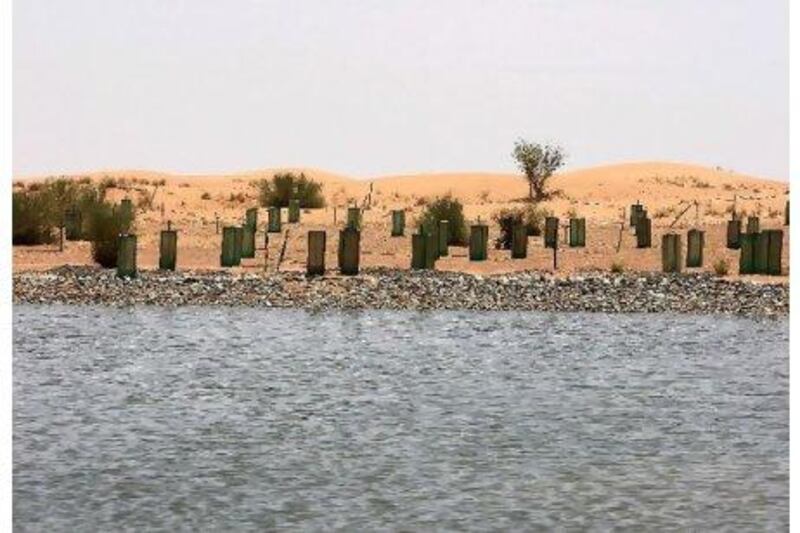DUBAI // Waterbirds are living and breeding in the middle of the desert thanks to a conservation project that has created two lakes amid the dunes.
Video:Tracking Flamingos in Abu Dhabi
Last Updated: Dec 30, 2010 UAE
The Environment Agency Abu Dhabi captures and tracks its 15th Flamingo as part of ongoing conservation efforts.
Although the lakes at the Dubai Desert Conservation Reserve were completed only eight months ago, they have already attracted breeding pairs of two types of waterbird: the black-wing stilt and the little ring plover.
"We saw the plovers' chicks a month-and-a-half ago, and the black-wing stilts have also hatched," said Greg Simkins, the reserve's conservation manager. "There are probably two pairs of little ring plovers mating, and there are a number of black-wing stilt pairs. Both lay their eggs on little hollows between the rocks.
"We've seen both species before at our waterholes, they'd stay for a day or two, but now they're permanent and they're breeding. They'll stay all year - they're here now, and this is the time of year when anyone who wants to get out of here goes."
The water for the lakes comes from a vast underground supply - one of the largest in Dubai - that lies beneath the reserve. Rainwater runs off the Hajar mountains, which are 30 kilometres away, and seeps into the desert sand before coming to rest on a clay layer 30 metres beneath the reserve.
"The water sits in the sand, there's not an underground lake, but the sand is wet. We put in a submersible pump and what happens is initially you'll pump the sand and then you'll create a cave and the water seeps into that and we pump it from there."
The chicks are not carefree in their oases, however. The reserve is home to a number of predators, including foxes and Gordon's wild cat.
"Snakes could also catch a couple of these guys, as could other birds - we see common kestrels here all the time," added Mr Simkins. "But some will make it through."
The lakes have even attracted seabirds, including a red-necked phalarope.
"They do stop on freshwater lakes on occasion, obviously he was migrating and decided to take a break, he was here for about a week. It was the first time we saw one in the reserve.
"The lesser sand plover was also a new one for us, it was also here for a week. It's normally seen in mangroves and coastal areas in the UAE."
MORE UAE NEWS: Our pick of today's top local news stories
Last Updated: June 23, 2011
Universities to start year with Dh428m funds shortfall Institutions claim the funding system requires urgent changes as three of the country's largest universities face major shortages at the start of the academic year. Read
Fuel pumps to restart or Enoc, Eppco ordered to close in Sharjah Emirate's rulers announce ultimatum to Enoc after Sheikh Mohammed bin Zayed directs Adnoc to adress the month-long shortage. Read article
Dubai Zoo debate heats up The 20,000 square metre park is constantly criticised, with even officials admitting animals have hardly any space to enjoy. Read article
Expatriates reveal why they adopt national dress and customs Imitation may be the sincerest form of flattery but Emiratis say expatriates who adopt their customs and clothing should also conform to the behaviour expected of nationals. Read article
[ MORE UAE NEWS ]
The project was initiated two years ago by Sheikh Mohammed bin Rashid, Vice President of the UAE and Ruler of Dubai. Indigenous trees and shrubs, such as ghafs, acacias and firebushes have been planted around the lakes. These provide a habitat for insects, which will in turn attract more birds.
At present the trees are protected from grazing animals by green mesh boxes, but in time, as they grow, the boxes will be removed.
"The next big thing is to move on from having trees in boxes to having trees that provide shelter and nesting sites. In two or three years' time we'll move to the next phase, it will start to take on a much more natural appearance.
"It will take time for it to settle and for species to get used to using it, and at that point we would expect more birds to come in. It's going to attract desert birds, and a lot of waterbirds are going to move into the area as they migrate over in spring and autumn.
"We'll get a lot more migrants stopping in both the lakes once the trees are a bit more grown, so there's definitely an advantage in having these lakes here."
Mr Simkins said he planned to install bird hides around the lakes, but added: "We haven't done it yet because we want to get a better pattern of where the birds are settling and where they're comfortable. If we build a hide and then in a year's time all the birds are sitting on the other side of the lake there's no point."





